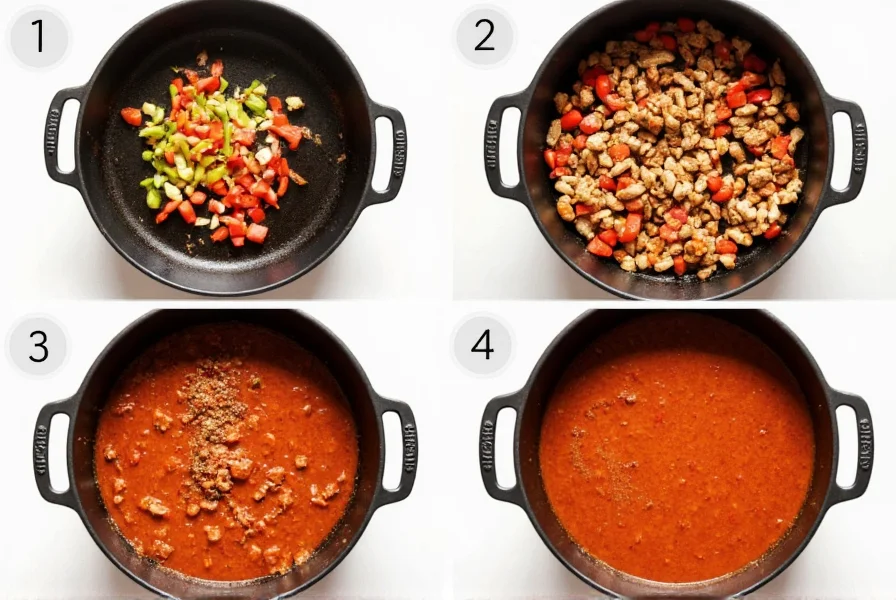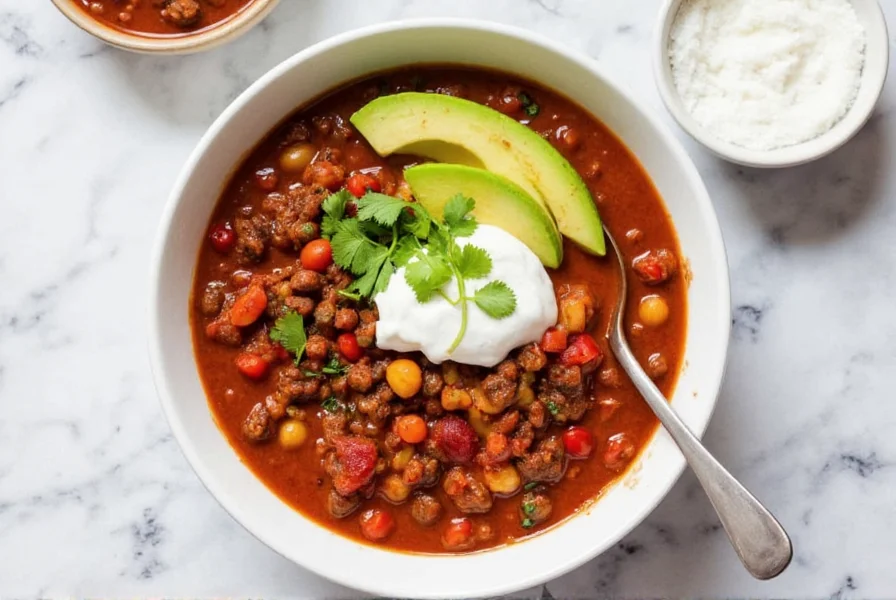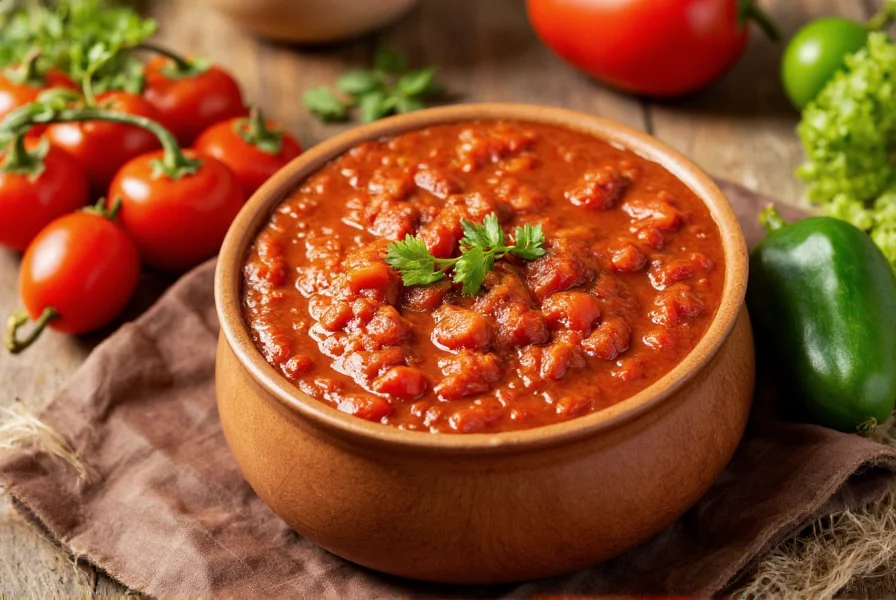Creating exceptional vegetarian chili requires understanding how to build flavor depth without meat. The secret lies in proper fundamental cooking techniques rather than relying on meat substitutes. When prepared correctly, vegetarian chili offers complete protein, high fiber content, and rich antioxidant benefits that make it both nutritionally superior and deeply satisfying.
The Essential Components of Authentic Vegetarian Chili
While regional variations exist, authentic vegetarian chili maintains certain core elements that distinguish it from ordinary bean soup. The foundation consists of three critical components:
| Component | Key Ingredients | Function |
|---|---|---|
| Bean Base | Kidney beans, black beans, pinto beans | Provides protein, texture, and heartiness |
| Aromatics | Onions, garlic, bell peppers, celery | Builds flavor foundation through caramelization |
| Tomato Base | Fire-roasted tomatoes, tomato paste | Creates acidity and depth; concentrate paste for richness |
Professional chefs achieve restaurant-quality vegetarian chili by toasting spices in oil before adding liquids—this technique unlocks essential oils in chili powder and cumin that water-based cooking cannot replicate. For an easy vegetarian chili recipe for beginners, start with one tablespoon of oil, two tablespoons of chili powder, and one tablespoon of cumin heated gently until fragrant (about 30 seconds) before proceeding.
Step-by-Step Preparation Guide
Follow this method for deeply flavorful vegetarian chili that satisfies even meat lovers:
- Sauté aromatics: Cook diced onions, bell peppers, and celery in olive oil over medium heat until translucent (8-10 minutes)
- Toast spices: Add chili powder, cumin, smoked paprika, and oregano; cook 1 minute until fragrant
- Add tomato base: Stir in tomato paste and cook 2 minutes to deepen flavor
- Combine beans: Add drained kidney beans, black beans, and pinto beans with their liquid
- Add tomatoes: Pour in fire-roasted diced tomatoes and vegetable broth
- Simmer: Cook uncovered for 45-60 minutes, stirring occasionally

This vegetarian chili without meat substitute approach creates authentic flavor through technique rather than imitation products. The extended simmering time allows flavors to meld while natural starches from the beans thicken the chili to perfect consistency.
Nutritional Benefits and Dietary Considerations
A single serving of properly prepared vegetarian chili delivers remarkable nutritional value:
- Complete protein profile from combined beans and grains
- 12-15g dietary fiber per serving (50% of daily requirement)
- Rich in antioxidants from tomatoes, peppers, and spices
- Low glycemic index suitable for diabetes management
- Heart-healthy with no saturated fats from animal products
For those following specific dietary patterns, this vegetarian chili for meal prep adapts beautifully. Make it gluten-free by ensuring broth and spices are certified GF. Create a vegan version by omitting dairy toppings. The dish freezes exceptionally well for batch cooking—portion into containers for ready-made lunches throughout the week.
Regional Variations and Creative Twists
While Texas-style chili traditionally contains no beans, most vegetarian adaptations incorporate them for texture and protein. Consider these authentic regional approaches:
- Southwestern style: Add corn, zucchini, and chipotle peppers for smoky heat
- Cincinnati-inspired: Include a touch of cocoa powder and cinnamon for depth
- California fusion: Stir in avocado and fresh cilantro before serving
- Slow cooker method: Combine all ingredients and cook on low for 6-8 hours
For those wondering how to make vegetarian chili taste like meat, the secret involves umami-rich ingredients: mushrooms, soy sauce, liquid smoke, and tomato paste. Sear diced portobello mushrooms separately before adding to create meaty texture without substitutes.
Perfect Pairings and Serving Suggestions
Elevate your vegetarian chili with kidney beans and black beans with these professional presentation tips:
- Serve in pre-warmed bowls to maintain temperature
- Offer a variety of toppings: avocado, sour cream (or vegan alternative), shredded cheese, green onions
- Pair with cornbread or whole-grain crackers for texture contrast
- Garnish with fresh cilantro for color and brightness

The ideal vegetarian chili toppings ideas create textural contrast—creamy elements balance the hearty beans while fresh ingredients cut through the richness. For meal prep enthusiasts, store toppings separately to maintain optimal texture when reheating.
Storage and Reheating Best Practices
Proper storage maximizes flavor development in vegetarian chili:
- Cool completely before refrigerating (within 2 hours of cooking)
- Store in airtight containers for up to 5 days in refrigerator
- Freeze in portion-sized containers for up to 3 months
- Reheat gently on stove with splash of broth to restore consistency
Interestingly, vegetarian chili often tastes better the next day as flavors continue to meld. When reheating frozen portions, thaw overnight in refrigerator before gentle reheating. Avoid microwave reheating which can create uneven temperatures and compromise texture.
Frequently Asked Questions
What are the best beans for vegetarian chili?
The optimal combination includes kidney beans for texture, black beans for earthiness, and pinto beans for creaminess. For an easy vegetarian chili recipe for beginners, use two 15-ounce cans of mixed beans (kidney, black, and pinto). Drain and rinse canned beans thoroughly to remove excess sodium and the starchy liquid that can make chili cloudy.
How can I make vegetarian chili thicker without flour?
Professional chefs thicken chili naturally by mashing some beans against the pot wall during cooking or simmering uncovered to reduce liquid. For vegetarian chili for meal prep, remove one cup of chili, blend until smooth, then return to the pot. The natural starches from the beans create perfect thickness without altering flavor.
What gives vegetarian chili authentic smoky flavor?
Authentic smokiness comes from properly toasted spices (especially smoked paprika), fire-roasted tomatoes, and optionally a small amount of liquid smoke (1/4 teaspoon). For vegetarian chili without meat substitute, sear mushrooms separately to create natural umami. Chipotle peppers in adobo sauce (1-2 tablespoons) add both heat and authentic smoke without artificial flavors.
How long should vegetarian chili simmer for best flavor?
For optimal flavor development, simmer vegetarian chili uncovered for 45-60 minutes after all ingredients are combined. The extended cooking time allows flavors to meld while natural starches from beans thicken the chili. For slow cooker vegetarian chili instructions, cook on low for 6-8 hours—the longer, slower cooking creates exceptionally tender beans and deeper flavor complexity.
Can I make vegetarian chili in an Instant Pot?
Yes, Instant Pot preparation works well for vegetarian chili with kidney beans and black beans. Use the sauté function for aromatics and spices, then add remaining ingredients. Cook on high pressure for 10 minutes with natural release for 15 minutes. The pressure cooking method significantly reduces time while maintaining excellent texture—ideal for weeknight meals when following vegetarian chili for meal prep strategies.











 浙公网安备
33010002000092号
浙公网安备
33010002000092号 浙B2-20120091-4
浙B2-20120091-4